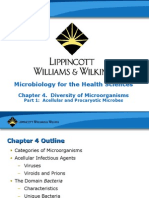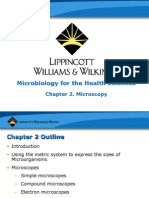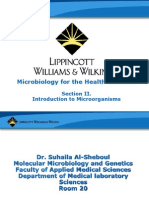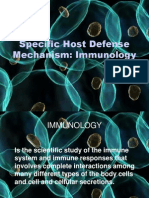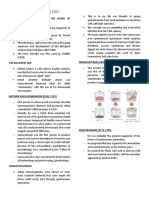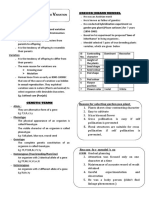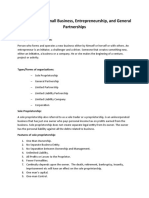Chapter 04
Chapter 04
Uploaded by
meena jeerhCopyright:
Available Formats
Chapter 04
Chapter 04
Uploaded by
meena jeerhCopyright
Available Formats
Share this document
Did you find this document useful?
Is this content inappropriate?
Copyright:
Available Formats
Chapter 04
Chapter 04
Uploaded by
meena jeerhCopyright:
Available Formats
Burton's Microbiology
for the Health Sciences
Chapter 4. Microbial Diversity
Part 1: Acellular and Procaryotic Microbes
Copyright © 2011 Wolters Kluwer Health | Lippincott Williams & Wilkins
Chapter 4 Outline
• Introduction
• Acellular Infectious Agents
– Viruses
– Viroids and Prions
• The Domain Bacteria
– Characteristics
– Unique Bacteria
– Photosynthetic Bacteria
• The Domain Archaea
Copyright © 2011 Wolters Kluwer Health | Lippincott Williams & Wilkins
Categories of Microorganisms
• Microbes can be divided into those that are truly cellular
(bacteria, archaea, algae, protozoa, and fungi) and those
that are acellular (viruses, viroids, and prions).
• Cellular microbes (microorganisms) can be divided into
those that are procaryotic (bacteria and archaea) and
those that are eucaryotic (algae, protozoa, and fungi).
• Viruses, viroids and prions are often referred to as
acellular microbes or infectious particles.
Copyright © 2011 Wolters Kluwer Health | Lippincott Williams & Wilkins
Acellular Microbes
• Viruses
– Complete virus particles are called virions.
– Most viruses are from 10 to 300 nm in diameter.
– Viruses infect humans, animals, plants, fungi,
protozoa, algae and bacterial cells.
– Some viruses, called oncogenic viruses or
oncoviruses, cause specific types of cancer.
– A typical virion consists of a genome of either DNA or
RNA, surrounded by a capsid (protein coat) which is
composed of protein units called capsomeres.
– Some viruses (enveloped viruses) have an outer
envelope composed of lipids and polysaccharides.
Copyright © 2011 Wolters Kluwer Health | Lippincott Williams & Wilkins
Acellular Microbes, cont.
Viruses have 5 properties that distinguish them from living
cells:
1. They possess either DNA or RNA – living cells
possess both.
2. They are unable to replicate on their own.
3. Unlike cells, they do not divide by binary fission,
mitosis, or meiosis.
4. They lack the genes and enzymes necessary for
energy production.
5. They depend on the ribosomes, enzymes, and
metabolites of the host cell for protein and nucleic
acid production.
Copyright © 2011 Wolters Kluwer Health | Lippincott Williams & Wilkins
Acellular Microbes, cont.
• Viruses are classified by:
• Type of genetic material (either DNA or RNA)
• Shape and size of capsid
• Number of capsomeres
• Presence or absence of an envelope
• Type of host it infects
• Disease it produces
• Target cell(s)
• Immunologic/antigenic properties
Copyright © 2011 Wolters Kluwer Health | Lippincott Williams & Wilkins
Acellular Microbes, cont.
Viruses
– There are 4 categories of viruses, based on the type
of nucleic acid that they possess. Most viral genomes
are of the first two types.
• Double-stranded DNA viruses
• Single-stranded RNA viruses
• Single-stranded DNA viruses
• Double-stranded RNA viruses
– Most viral genomes are circular molecules, but some
are linear.
Copyright © 2011 Wolters Kluwer Health | Lippincott Williams & Wilkins
Herpesviruses acquiring their envelopes as they
leave a host cell’s nucleus by budding.
Copyright © 2011 Wolters Kluwer Health | Lippincott Williams & Wilkins
Copyright © 2011 Wolters Kluwer Health | Lippincott Williams & Wilkins
Comparative sizes
of virions, their
nucleic acids, and
bacteria.
Copyright © 2011 Wolters Kluwer Health | Lippincott Williams & Wilkins
Acellular Microbes, cont.
Bacteriophages
Viruses that infect bacteria are known as bacteriophages or
simply phages.
There are two categories of bacteriophages: virulent
bacteriophages and temperate bacteriophages.
Virulent bacteriophages always cause what is known as the
lytic cycle, which ends with the destruction of the bacterial
cell.
The 5 steps in the lytic cycle are attachment, penetration,
biosynthesis, assembly, and release.
Copyright © 2011 Wolters Kluwer Health | Lippincott Williams & Wilkins
A partially lysed cell of Vibrio cholerae with
attached virions of phage CP-T1.
Copyright © 2011 Wolters Kluwer Health | Lippincott Williams & Wilkins
The bacteriophage T4 is an Viral DNA enters the
assembly of protein components. cell through the core.
20
facets,
filled with
DNA
Copyright © 2011 Wolters Kluwer Health | Lippincott Williams & Wilkins
Copyright © 2011 Wolters Kluwer Health | Lippincott Williams & Wilkins
Acellular Microbes, cont.
Animal Viruses
– The steps in multiplication of animal viruses are:
• Attachment
• Penetration
• Uncoating
• Biosynthesis
• Assembly
– Animal viruses escape from their host cells either by
lysis of the cell or budding. Viruses that escape by
budding become enveloped viruses.
Copyright © 2011 Wolters Kluwer Health | Lippincott Williams & Wilkins
Multiplication of Herpes Simplex on HeLa Cells
Adsorption Penetration Penetration Penetration
Uncoating Uncoating Uncoating
Copyright © 2011 Wolters Kluwer Health | Lippincott Williams & Wilkins
Copyright © 2011 Wolters Kluwer Health | Lippincott Williams & Wilkins
Acellular Microbes, cont.
• Latent Virus Infections
– Viral infections in which the virus is able to hide from
a host’s immune system by entering cells and
remaining dormant.
– Herpes viral infections are examples.
– Once acquired, herpes virus infections (e.g., those
that cause cold sores, genital herpes, and
chickenpox/shingles) never completely go away; for
example, chickenpox may be followed, years later,
by shingles - both the result of the same virus.
Copyright © 2011 Wolters Kluwer Health | Lippincott Williams & Wilkins
Acellular Microbes, cont.
• Antiviral Agents
– Antibiotics are not effective against viral infections.
– Antiviral agents are drugs that are used to treat viral
infections.
– These agents interfere with virus-specific enzymes
and virus production by disrupting critical phases in
viral multiplication or inhibiting synthesis of viral
DNA, RNA, or proteins.
Copyright © 2011 Wolters Kluwer Health | Lippincott Williams & Wilkins
Acellular Microbes, cont.
• Oncogenic Viruses or Oncoviruses
– Viruses that cause cancer.
– Examples include Epstein-Barr virus, human
papillomaviruses, and HTLV-1.
• Human Immunodeficiency Virus (HIV)
– The cause of acquired immunodeficiency syndrome
(AIDS).
– It is an enveloped, single-stranded RNA virus.
– The primary targets for HIV are CD4+ cells.
Copyright © 2011 Wolters Kluwer Health | Lippincott Williams & Wilkins
Human Immunodeficiency Virus (HIV)
Copyright © 2011 Wolters Kluwer Health | Lippincott Williams & Wilkins
Acellular Microbes, cont.
• Viroids and Prions (smaller and less complex infectious
particles than viruses)
– Viroids
• Viroids are short, naked fragments of single-
stranded RNA, which can interfere with the
metabolism of plant cells.
• Viroids are transmitted between plants in the same
manner as viruses.
• Examples of plant diseases caused by viroids:
potato spindle tuber and citrus exocortis.
Copyright © 2011 Wolters Kluwer Health | Lippincott Williams & Wilkins
Acellular Microbes, cont.
• Prions
– Prions are small infectious proteins that cause fatal
neurologic diseases in animals; examples: Scrapie,
Bovine Spongiform Encephalopathy (“Mad Cow
Disease”) and Creutzfeldt-Jacob disease.
– Of all pathogens, prions are the most resistant to
disinfectants.
– The mechanism by which prions cause disease
remains a mystery.
Copyright © 2011 Wolters Kluwer Health | Lippincott Williams & Wilkins
The Domain Bacteria
Characteristics
• Bacteria are divided into 3 major phenotypic categories:
– Those that are Gram-negative and have a cell wall
– Those that are Gram-positive and have a cell wall
– Those that lack a cell wall (Mycoplasma spp.)
• Characteristics of bacteria used in classification and
identification include: cell morphology, staining reactions,
motility, colony morphology, atmospheric requirements,
nutritional requirements, biochemical and metabolic
activities, enzymes that the organism produces,
pathogenicity, and genetic composition.
Copyright © 2011 Wolters Kluwer Health | Lippincott Williams & Wilkins
The Domain Bacteria
Cell Morphology
• There are 3 basic categories of bacteria, based on shape:
– Cocci (round bacteria)
– Bacilli (rod-shaped bacteria)
– Curved and spiral-shaped bacteria
• Cocci may be seen singly or in pairs (diplococci), chains
(streptococci), clusters (staphylococci), packets of 4
(tetrads), or packets of 8 (octads).
• The average coccus is about 1 µm in diameter.
• Some cocci have “coccus” in their name.
Copyright © 2011 Wolters Kluwer Health | Lippincott Williams & Wilkins
Categories of Bacteria Based on the
Shape of Their Cells
Copyright © 2011 Wolters Kluwer Health | Lippincott Williams & Wilkins
Copyright © 2011 Wolters Kluwer Health | Lippincott Williams & Wilkins
Morphologic Arrangements of Cocci
Gram-positive Staphylococcus aureus SEM of Streptococcus mutans
in clusters. illustrating cocci in chains.
Copyright © 2011 Wolters Kluwer Health | Lippincott Williams & Wilkins
Diagram Showing Various Forms of
Bacteria That Might be Observed in Gram-
Stained Smears
Copyright © 2011 Wolters Kluwer Health | Lippincott Williams & Wilkins
The Domain Bacteria
Cell Morphology, cont.
• Bacilli
– Often referred to as rods; may be short or long, thick
or thin, and pointed or with curved or blunt ends.
– They may occur singly, in pairs (diplobacilli), in
chains (streptobacilli), in long filaments, or branched.
– An average sized bacillus is 1 x 3 µm.
– Extremely short bacilli are called coccobacilli.
– Examples of medically important bacilli:
Escherichia, Klebsiella, and Proteus spp.
Pseudomonas, Haemophilus, and Bacillus spp.
Copyright © 2011 Wolters Kluwer Health | Lippincott Williams & Wilkins
The Domain Bacteria
Cell Morphology, cont.
• Curved and Spiral-Shaped Bacteria
– Examples of curved bacteria:
• Vibrio spp.
• Campylobacter spp.
• Helicobacter spp.
– Examples of spiral-shaped bacteria:
• Treponema spp.
• Borrelia spp.
Copyright © 2011 Wolters Kluwer Health | Lippincott Williams & Wilkins
Spiral-Shaped Bacteria
Borrelia hermsii in a
stained blood smear; a
cause of relapsing fever.
Copyright © 2011 Wolters Kluwer Health | Lippincott Williams & Wilkins
Copyright © 2011 Wolters Kluwer Health | Lippincott Williams & Wilkins
Domain Bacteria
Staining Procedures
• Three Major Categories of Staining Procedures
1. Simple stains
2. Structural staining procedures
• Capsule stains
• Spore stains
• Flagella stains
3. Differential staining procedures
• Gram and acid-fast staining procedures
Copyright © 2011 Wolters Kluwer Health | Lippincott Williams & Wilkins
Domain Bacteria
Staining Procedures, cont.
• Bacterial smears must be fixed prior to staining
• The fixation process serves to kill organisms, preserve
their morphology, and anchors the smear to the slide
• The two most common types of fixation:
– Heat-fixation; not a standardized technique;
excess heat will distort bacterial morphology
– Methanol-fixation; a standardized technique; the
preferred method
Copyright © 2011 Wolters Kluwer Health | Lippincott Williams & Wilkins
Simple Bacterial Staining Technique
Copyright © 2011 Wolters Kluwer Health | Lippincott Williams & Wilkins
Domain Bacteria
The Gram Staining Procedure
• Divides bacteria into 2 major groups:
– Gram-positive (bacteria are blue-to-purple)
– Gram-negative (bacteria are pink-to-red)
• The final Gram reaction (positive or negative) depends upon
the organism’s cell wall structure.
– The cell walls of Gram-positive bacteria have a thick layer
of peptidoglycan, making it difficult to remove the crystal
violet-iodine complex.
– Gram-negative organisms have a thin layer of
peptidoglycan, making it easier to remove the crystal
violet; the cells are subsequently stained with safranin.
Copyright © 2011 Wolters Kluwer Health | Lippincott Williams & Wilkins
Copyright © 2011 Wolters Kluwer Health | Lippincott Williams & Wilkins
Copyright © 2011 Wolters Kluwer Health | Lippincott Williams & Wilkins
Various Gram-Positive Bacteria
Chains of streptococci in Streptococcus pneumoniae in
smear from broth culture. blood culture.
Copyright © 2011 Wolters Kluwer Health | Lippincott Williams & Wilkins
Various Gram-Positive Bacteria
Spores
Copyright © 2011 Wolters Kluwer Health | Lippincott Williams & Wilkins Copyright © 2011 Wolters Kluwer Health | Lippincott Williams & Wilkins
A bacillus, Clostridium perfringens, Clostridium tetani in a smear from
in a smear from a broth culture. a broth culture (note terminal spores on
some cells).
Copyright © 2011 Wolters Kluwer Health | Lippincott Williams & Wilkins
Various Gram-Positive Bacteria
Epithelial cells
Many Gram-positive bacteria
Copyright © 2011 Wolters Kluwer Health | Lippincott Williams & Wilkins
Copyright © 2011 Wolters Kluwer Health | Lippincott Williams & Wilkins
Gram-Negative Bacteria
Gram-negative bacilli in a smear Loosely coiled Gram-negative
from a bacterial colony. spirochetes, Borrelia burgdorferi,
the cause of Lyme disease.
Copyright © 2011 Wolters Kluwer Health | Lippincott Williams & Wilkins
Domain Bacteria
Staining Procedures, cont.
• Some bacteria are neither consistently purple nor pink
after Gram staining; they are known as Gram-variable
bacteria; example, Mycobacterium spp.
• Mycobacterium spp. are often identified using the acid-
fast stain.
• The acid-fast stain
– Carbol fuchsin is the red dye that is driven through
the bacterial cell wall
– Heat is used to soften the waxes in the cell wall
– Because mycobacteria are not decolorized by the
acid-alcohol mixture, they are said to be acid-fast
Copyright © 2011 Wolters Kluwer Health | Lippincott Williams & Wilkins
Domain Bacteria
Acid-Fast Mycobacteria
Copyright © 2011 Wolters Kluwer Health | Lippincott Williams & Wilkins Copyright © 2011 Wolters Kluwer Health | Lippincott Williams & Wilkins
Many acid-fast mycobacteria in a Acid-fast bacilli in a digested
liver biopsy. sputum specimen.
Copyright © 2011 Wolters Kluwer Health | Lippincott Williams & Wilkins
Domain Bacteria
Motility
• If a bacterium is able to “swim,” it is said to be motile.
• Bacterial motility is most often associated with flagella;
less often with axial filaments.
• Most spiral-shaped bacteria and about 50% of bacilli are
motile; cocci are generally nonmotile.
• Motility can be demonstrated by stabbing the bacteria
into a tube of semisolid medium or by using the hanging-
drop technique.
Copyright © 2011 Wolters Kluwer Health | Lippincott Williams & Wilkins
Semisolid Agar Method for Determining Motility
Nonmotile Motile
Copyright © 2011 Wolters Kluwer Health | Lippincott Williams & Wilkins
Copyright © 2011 Wolters Kluwer Health | Lippincott Williams & Wilkins
Hanging-Drop Prep for Study of Living Bacteria
Depression slide Depression slide with coverglass
Side view of hanging-drop prep.
Copyright © 2011 Wolters Kluwer Health | Lippincott Williams & Wilkins
Copyright © 2011 Wolters Kluwer Health | Lippincott Williams & Wilkins
Domain Bacteria
Colony Morphology
• A bacterial colony contains millions of organisms.
• Colony morphology (appearance of the colony) varies
from one species to another.
• Colony morphology includes: size, color, overall shape,
elevation, and the appearance of the edge or margin of
the colony.
• Colony morphology also includes the results of enzymatic
activity on various types of media.
• As is true for cell morphology and staining
characteristics, colony morphology is an important “clue”
to the identification of bacteria.
Copyright © 2011 Wolters Kluwer Health | Lippincott Williams & Wilkins
Size of colonies is
determined by the
organism’s generation
time and is another
important characteristic
of a particular bacterial
species.
Formation of a bacterial
colony on solid growth
medium; here, the
generation time is assumed
to be 30 minutes.
Copyright © 2011 Wolters Kluwer Health | Lippincott Williams & Wilkins
Domain Bacteria
Atmospheric Requirements
• Bacteria can be classified on the basis of their
atmospheric requirements, including their relationship to
O2 and CO2
• With respect to O2, bacterial isolates can be classified as:
– Obligate aerobes
– Microaerophilic aerobes
– Facultative anaerobes
– Aerotolerant anaerobes
– Obligate anaerobes
• Capnophilic organisms grow best in the presence of
increased concentrations of CO2 (usually 5 to 10%)
Copyright © 2011 Wolters Kluwer Health | Lippincott Williams & Wilkins
Domain Bacteria
Nutritional Requirements
• All bacteria need some form of the elements carbon,
hydrogen, oxygen, sulfur, phosphorus, and nitrogen for
growth.
• Some bacteria require special elements (e.g., calcium,
iron, or zinc).
• Organisms with especially demanding nutritional
requirements are said to be fastidious (“fussy”).
• The nutritional needs of a particular organism are usually
characteristic for that species and are sometimes
important clues to its identity.
Copyright © 2011 Wolters Kluwer Health | Lippincott Williams & Wilkins
Domain Bacteria
Biochemical and Metabolic Activities
• As bacteria grow, they produce many waste products and
secretions, some of which are enzymes.
• Pathogenic strains of many bacteria, like staphylococci
and streptococci, can be tentatively identified by the
enzymes they secrete.
• In particular environments, some bacteria produce gases
such as carbon dioxide or hydrogen sulfide.
• To identify bacteria in the lab, they are inoculated into
various substrates (i.e., carbohydrates and amino acids)
to determine whether they possess the enzymes
necessary to break down those substrates.
Copyright © 2011 Wolters Kluwer Health | Lippincott Williams & Wilkins
Domain Bacteria
Pathogenicity
• Many pathogens are able to cause disease because they
possess capsules, pili, or endotoxins, or because they
secrete exotoxins and exoenzymes that damage cells and
tissues.
• Frequently, pathogenicity is tested by injecting the
organism into mice or cell cultures.
• Examples of some common pathogenic bacteria:
– Neisseria meningitidis, Salmonella typhi, Shigella
spp., Vibrio cholerae, Yersina pestis, Treponema
pallidum
Copyright © 2011 Wolters Kluwer Health | Lippincott Williams & Wilkins
Domain Bacteria
Genetic Composition
• Laboratory identification of bacteria is moving toward
analyzing the organism’s DNA or RNA – techniques
collectively referred to as molecular diagnostic
procedures.
– The composition of the genetic material (DNA) of an
organism is unique to each species.
– DNA probes make it possible to identify an isolate
without relying on phenotypic characteristics.
• Through the use of 16S rRNA sequencing, the degree of
relatedness between 2 different bacteria can be
determined.
Copyright © 2011 Wolters Kluwer Health | Lippincott Williams & Wilkins
Unique Bacteria
• Rickettsias, chlamydias, and mycoplasmas are bacteria,
but they do not possess all the attributes of typical
bacterial cells.
• Rickettsias and chlamydias have a Gram-negative type of
cell wall and are obligate intracellular pathogens (i.e.,
they must live within a host cell; they cannot grow on
artificial culture media).
– Rickettsias have “leaky membranes.”
– Chlamydias are “energy parasites,” meaning they
prefer to use ATP molecules produced by their host
cell.
Copyright © 2011 Wolters Kluwer Health | Lippincott Williams & Wilkins
Rickettsia prowazekii, the cause of epidemic
louseborne typhus.
Copyright © 2011 Wolters Kluwer Health | Lippincott Williams & Wilkins
Copyright © 2011 Wolters Kluwer Health | Lippincott Williams & Wilkins
Unique Bacteria, cont.
• Mycoplasmas
– Smallest of the cellular microbes
– Lack a cell wall and therefore assume many shapes
(they are pleomorphic)
– In humans, pathogenic mycoplasmas cause primary
atypical pneumonia and genitourinary infections
– Because they have no cell wall, they are resistant to
drugs like penicillin that attack cell walls
– They produce tiny “fried egg” colonies on artificial
media
Copyright © 2011 Wolters Kluwer Health | Lippincott Williams & Wilkins
SEM of Mycoplasma pneumoniae
Copyright © 2011 Wolters Kluwer Health | Lippincott Williams & Wilkins
Photosynthetic Bacteria
• Photosynthetic bacteria include purple bacteria, green
bacteria, and cyanobacteria; they all use light as an
energy source, but not in the same way.
– Purple and green bacteria do not produce oxygen,
whereas cyanobacteria do.
– Photosynthesis that produces oxygen is called
oxygenic photosynthesis.
– Photosynthesis that does not produce oxygen is
called anoxygenic photosynthesis.
Copyright © 2011 Wolters Kluwer Health | Lippincott Williams & Wilkins
The Domain Archaea
• Archaea (meaning ancient) were discovered in 1977;
they are procaryotic organisms.
• Genetically, archaea are more closely related to
eucaryotes than they are to bacteria.
• Archaea vary widely in shape; some live in extreme
environments, such as extremely acidic, extremely hot,
or extremely salty environments.
• Archaea possess cell walls, but their cell walls do not
contain peptidoglycan (in contrast, all bacterial cell walls
contain peptidoglycan).
Copyright © 2011 Wolters Kluwer Health | Lippincott Williams & Wilkins
You might also like
- Microbial Diversity Part 1: Acellular and Prokaryotic MicrobesDocument53 pagesMicrobial Diversity Part 1: Acellular and Prokaryotic MicrobesSedqamNo ratings yet
- Chapter 6Document22 pagesChapter 6Marlop CasicasNo ratings yet
- Mystery OrganismDocument5 pagesMystery OrganismJilian McGuganNo ratings yet
- ICICI Business Model and InnovationDocument28 pagesICICI Business Model and InnovationVenkatesan Jayaraman33% (3)
- 7th Grade Unit 7 Ecosystems Assessment PKTDocument16 pages7th Grade Unit 7 Ecosystems Assessment PKTapi-366982317No ratings yet
- 25 Modeling & Valuation Best Practices: 25 Modeling & Valuation Best PracticesDocument42 pages25 Modeling & Valuation Best Practices: 25 Modeling & Valuation Best PracticesChandramouli KonduruNo ratings yet
- Chapter 4Document27 pagesChapter 4Blessy Martin100% (1)
- Microbiology For The Health Sciences: Chapter 4. Diversity of MicroorganismsDocument59 pagesMicrobiology For The Health Sciences: Chapter 4. Diversity of MicroorganismsHiba Abu-jumahNo ratings yet
- Chapter 6 The Biochemical Basis of LifeDocument54 pagesChapter 6 The Biochemical Basis of LifeJhane Kimberly A. Rustia100% (1)
- Microbiology For The Health Sciences: Section II. Introduction To MicroorganismsDocument48 pagesMicrobiology For The Health Sciences: Section II. Introduction To MicroorganismsHiba Abu-jumahNo ratings yet
- Microscope Lab - SKIN AND ONION CELLSDocument5 pagesMicroscope Lab - SKIN AND ONION CELLSrenier calumpangNo ratings yet
- Microbiology For The Health Sciences: Chapter 2. MicrosDocument23 pagesMicrobiology For The Health Sciences: Chapter 2. MicrosHashim Ghazo100% (1)
- Viruses BasicsDocument53 pagesViruses Basicsmokashe1987No ratings yet
- Controlling Micriobial GrowthDocument47 pagesControlling Micriobial GrowthasiNo ratings yet
- Bacteria (Unit I)Document22 pagesBacteria (Unit I)Muhammad KaleemNo ratings yet
- Chapter 7 Microbial Physiology and GeneticsDocument47 pagesChapter 7 Microbial Physiology and GeneticsJhane Kimberly A. RustiaNo ratings yet
- Bacon Quizlet Links KozierDocument3 pagesBacon Quizlet Links KozierMira MaravillaNo ratings yet
- Microbiology For The Health Sciences: Section II. Introduction To MicroorganismsDocument48 pagesMicrobiology For The Health Sciences: Section II. Introduction To MicroorganismsHashim Ghazo100% (1)
- Specific Host Defense Mechanism: ImmunologyDocument35 pagesSpecific Host Defense Mechanism: ImmunologyLouie O. DomingoNo ratings yet
- Developmental Biology Test I ReviewDocument12 pagesDevelopmental Biology Test I Reviewimbrium55No ratings yet
- Lymphatic SystemDocument70 pagesLymphatic SystemNang Maizana Megat Yahya100% (1)
- Chapter 03 - Cell Structure and FunctionDocument32 pagesChapter 03 - Cell Structure and FunctionKhadija Prescott100% (1)
- Viruses - Viroids - and PrionsDocument60 pagesViruses - Viroids - and Prionssanashar100% (1)
- Microbiology Parasitology Class OrientationDocument14 pagesMicrobiology Parasitology Class OrientationRam Christian VizarraNo ratings yet
- Antimicrobial DrugsDocument20 pagesAntimicrobial Drugsmaria adventia martinNo ratings yet
- Controlling Microbial Growth in Vivo Using Antimicrobial AgentsDocument30 pagesControlling Microbial Growth in Vivo Using Antimicrobial AgentsJen PanganibanNo ratings yet
- Burton's Microbiology For The Health Sciences: Section II. Introduction To Microbes and Cellular BiologyDocument41 pagesBurton's Microbiology For The Health Sciences: Section II. Introduction To Microbes and Cellular BiologyAlexander Donton100% (1)
- 2.1 Basic Microbiology TechniquesDocument31 pages2.1 Basic Microbiology TechniquesBelladonna LeeNo ratings yet
- Virus, Viroids and PrionsDocument33 pagesVirus, Viroids and PrionsShivaveerakumar S. ChandrikimathNo ratings yet
- Introduction of MicrobiologyDocument52 pagesIntroduction of MicrobiologyTri Wahyudi Iman DantaraNo ratings yet
- Food Microbiology & ParasitologyDocument138 pagesFood Microbiology & ParasitologynkaitolestephenNo ratings yet
- 11.2 Domain Bacteria and ArchaeaDocument39 pages11.2 Domain Bacteria and ArchaeaZkdlin SpaceNo ratings yet
- Scientific Method and Experimental DesignDocument40 pagesScientific Method and Experimental Designsheila may valiao-de asisNo ratings yet
- Genetics WorksheetsDocument3 pagesGenetics WorksheetsJohn ferdinand TamayoNo ratings yet
- Properties and Overview of Immune ResponsesDocument30 pagesProperties and Overview of Immune ResponsesVivien KasimNo ratings yet
- Respiratory Infections ....Document195 pagesRespiratory Infections ....Poorny PurushothNo ratings yet
- Cell DivisionDocument48 pagesCell DivisionMichaelNo ratings yet
- AP Bio Digestion System (Kfogler)Document34 pagesAP Bio Digestion System (Kfogler)julie rainesNo ratings yet
- ParasitologyDocument107 pagesParasitologyShimelis Teshome AyalnehNo ratings yet
- MIB1001 Lab Manual 2015-16Document68 pagesMIB1001 Lab Manual 2015-16Beautiful FlawsNo ratings yet
- Lab 02 - Preparation of Smears and Gram StainingDocument10 pagesLab 02 - Preparation of Smears and Gram StainingVincent ReyesNo ratings yet
- Module 1 - PSTMLSDocument53 pagesModule 1 - PSTMLSArvie Karl NabiNo ratings yet
- 1 - Introduction To ParasitologyDocument60 pages1 - Introduction To ParasitologyThesa TagalogNo ratings yet
- What's in A Cell - Worksheet & ColoringDocument2 pagesWhat's in A Cell - Worksheet & ColoringNuria Tarancon0% (1)
- Foundations in Microbiology: TalaroDocument38 pagesFoundations in Microbiology: TalaroadibwanNo ratings yet
- 1 History and Scope of MicrobiologyDocument5 pages1 History and Scope of MicrobiologyAlphonse Rossaint SambranoNo ratings yet
- Microbial NutritionDocument24 pagesMicrobial NutritionDeepak MudaraddiNo ratings yet
- ICSE Biology Economic Significance of MicroorganismsDocument42 pagesICSE Biology Economic Significance of MicroorganismsDebasish KunduNo ratings yet
- Functional Anatomy of Prokaryotic and Eukaryotic CellsDocument70 pagesFunctional Anatomy of Prokaryotic and Eukaryotic CellsTrixie De GuzmanNo ratings yet
- History and Branches of MicrobiologyDocument77 pagesHistory and Branches of Microbiologyrafaqat ahmedNo ratings yet
- Transgenic Organisms: Alba Elvira and Patricia Cea 4º BDocument24 pagesTransgenic Organisms: Alba Elvira and Patricia Cea 4º BAlba Elvira BurgosNo ratings yet
- Biodiversity, Biotechnology, and BioengineeringDocument7 pagesBiodiversity, Biotechnology, and BioengineeringCamia SinagdaNo ratings yet
- 2021 Expt 7 Pre Lab - Diversity of BacteriacDocument2 pages2021 Expt 7 Pre Lab - Diversity of BacteriacjijiqNo ratings yet
- Berman Ch28 Lecture VITAL SIGNSDocument75 pagesBerman Ch28 Lecture VITAL SIGNSoking4831No ratings yet
- Antigens & Antigen Presentation: Prof Anura WeerasingheDocument21 pagesAntigens & Antigen Presentation: Prof Anura Weerasinghesiva100% (1)
- History of MicrobiologyDocument5 pagesHistory of MicrobiologyBernadine EliseNo ratings yet
- P O I A V: Reason For Selecting Garden Pea PlantDocument22 pagesP O I A V: Reason For Selecting Garden Pea PlantDr. Remya RanjithNo ratings yet
- PHCG 201 CytologyDocument113 pagesPHCG 201 CytologyIbn HaarūnNo ratings yet
- Developmental BiologyDocument9 pagesDevelopmental BiologyZahraa TermosNo ratings yet
- Lecture - Microbial Diversity The Eukaryotic Microbes - Chapter 4 - BSEDDocument5 pagesLecture - Microbial Diversity The Eukaryotic Microbes - Chapter 4 - BSEDMaden betoNo ratings yet
- Tortora Chapter 10Document31 pagesTortora Chapter 10Eman Maleeha100% (2)
- Micrology and Parasitology ReviewerDocument44 pagesMicrology and Parasitology Reviewermarjourie cadampog100% (1)
- Mycobacteria: Molecular Biology and VirulenceFrom EverandMycobacteria: Molecular Biology and VirulenceC. RatledgeNo ratings yet
- 4 - Conceptual Framework: Elements of Financial StatementsDocument7 pages4 - Conceptual Framework: Elements of Financial Statementsagm25No ratings yet
- Resume SampleDocument2 pagesResume SampleOmvir Bhardwaj0% (1)
- Details of C1F1 Details of C2F2: Scale 1:20 Mts Scale 1:20 MtsDocument1 pageDetails of C1F1 Details of C2F2: Scale 1:20 Mts Scale 1:20 MtsCharlene Anne Austria VillarozaNo ratings yet
- Sapgui750 Mac Installation PDFDocument10 pagesSapgui750 Mac Installation PDFMai ShiranuiNo ratings yet
- Victoria Brown Coal PropertiesDocument401 pagesVictoria Brown Coal PropertiesShahabuddin SuzanNo ratings yet
- Statement of Account: Date Narration Chq./Ref - No. Value DT Withdrawal Amt. Deposit Amt. Closing BalanceDocument11 pagesStatement of Account: Date Narration Chq./Ref - No. Value DT Withdrawal Amt. Deposit Amt. Closing BalanceMohan ChaudharyNo ratings yet
- Adafruit AM2320 Temperature & Humidity I2C Sensor User ManualDocument11 pagesAdafruit AM2320 Temperature & Humidity I2C Sensor User ManualgabrieldeclercqNo ratings yet
- Term 2 English Year 3Document30 pagesTerm 2 English Year 3Tisha Nair ടിഷ നായര്No ratings yet
- Class 4-MATHS Asssignment - Holiday HW-Answer KeyDocument14 pagesClass 4-MATHS Asssignment - Holiday HW-Answer Keyruchi gulatiNo ratings yet
- The History and Evolution of EngineeringDocument2 pagesThe History and Evolution of EngineeringZack Norman100% (1)
- Installation and Operation Instructions Dürr CompressorsDocument27 pagesInstallation and Operation Instructions Dürr CompressorsHEINER_PNo ratings yet
- FS - Barquiron (Group5)Document6 pagesFS - Barquiron (Group5)Angel TulangNo ratings yet
- 2.vol 2a Draft Concession Agreement 10.10.2018Document168 pages2.vol 2a Draft Concession Agreement 10.10.2018kmmanoj1968No ratings yet
- Lycaa FSD Ops Checklist 08Document4 pagesLycaa FSD Ops Checklist 08Nabil BadiNo ratings yet
- Alphanumeric Series PDF by Governmentadda PDFDocument36 pagesAlphanumeric Series PDF by Governmentadda PDFSitanshu SharmaNo ratings yet
- Angolia J., Taylor H. Uniforms, Organization and History of The German Police. Vol. 2 (2009), OCRDocument812 pagesAngolia J., Taylor H. Uniforms, Organization and History of The German Police. Vol. 2 (2009), OCRLGAW100% (2)
- Chapter#act 34 Small Business, Entrepreneurship, and General PartnershipsDocument57 pagesChapter#act 34 Small Business, Entrepreneurship, and General PartnershipsAhsan AliNo ratings yet
- Food Processing in Classical RomeDocument305 pagesFood Processing in Classical RomeRenato Baba Looey100% (8)
- R-1460 - E04.04-02 - 001-REV.2 (Calculations) - ApprovedDocument126 pagesR-1460 - E04.04-02 - 001-REV.2 (Calculations) - ApprovedDan PastorNo ratings yet
- Winner Announcement Icb Los 01Document1 pageWinner Announcement Icb Los 01guntur gioxsNo ratings yet
- Final BBA (CA) - Structure - UpdatesDocument8 pagesFinal BBA (CA) - Structure - UpdatesYogeshNo ratings yet
- Sendak StudyDocument10 pagesSendak StudychbenengeliNo ratings yet
- Using The Publish and Subscribe Pattern For Notifications SlidesDocument44 pagesUsing The Publish and Subscribe Pattern For Notifications SlidesancgateNo ratings yet
- Arihant Master Resource Book in Phy For JEE Mains 2022Document1,118 pagesArihant Master Resource Book in Phy For JEE Mains 2022Parth Khandelwal100% (3)
- The Boy Who Knew Me When - From Bostick - J.L - PDFDocument245 pagesThe Boy Who Knew Me When - From Bostick - J.L - PDFNidia CecchettoNo ratings yet
- Datasheet de LedsDocument60 pagesDatasheet de Ledscristiano1989No ratings yet
- Shadowrun ArtistHandbook v01.00.00Document183 pagesShadowrun ArtistHandbook v01.00.00Natasha CraftNo ratings yet







